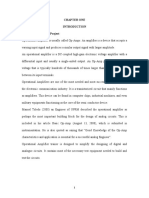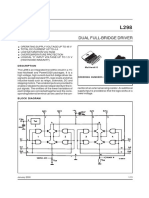HearignAid English V1.1
HearignAid English V1.1
Uploaded by
vigyanashramCopyright:
Available Formats
HearignAid English V1.1
HearignAid English V1.1
Uploaded by
vigyanashramCopyright
Available Formats
Share this document
Did you find this document useful?
Is this content inappropriate?
Copyright:
Available Formats
HearignAid English V1.1
HearignAid English V1.1
Uploaded by
vigyanashramCopyright:
Available Formats
IBT Instructor Training April 2012
Prepared by
( )
For
IBT Training April 2012
Dates 27/04/2012 28/04/2012 25/05/2012 27/05/2012 12/06/12 Version 0.1 0.2 0.3 1 1.1 Author Vigyan Ashram, Fablab Vigyan Ashram, Fablab Vigyan Ashram, Fablab Vigyan Ashram, Fablab Vigyan Ashram, Fablab Notes Created document in Hindi Updated document with appropriate figures Translated document in English Updated document with corrections and images Corrected a few spellings.
Low cost, Qualitative Hearing Aid
IBT Instructor Training April 2012
Table of Contents
Low cost qualitative Hearing Aid...........................................................................................................3 Introduction - ..........................................................................................................................3 Scope of the problem...............................................................................................................3 What can be done?..................................................................................................................3 The device...............................................................................................................................3 Amplification -.....................................................................................................4 Microphone (mic) -..............................................................................................4 Design...................................................................................................................6 Background .........................................................................................................7 Material list and tentative price............................................................................8 Scope ahead.............................................................................................................................8 Propagation..............................................................................................................................9 References...............................................................................................................................9
Low cost, Qualitative Hearing Aid
IBT Instructor Training April 2012
Low cost qualitative Hearing Aid Introduction A very special note about human-ear is that humans do not posses control over activity of this vital organ. An incidental sound has to be heard by a human being unless she /he is sleeping or unconscious. Ofcourse there are artificial ways, but natural. However, another fact is that everyone of us may have different capacities of listening to the same sound. We range from people who can listen to even a slightest noise to people completely deaf. This particular document intends to connect a technological solution (to this problem) and the socio-economical (and why not political) conditions in India (and like countries).
Scope of the problem
We observe atleast two verticals to address. Our schooling system has to do numerous improvements when it comes to educational quality and then logistics. A few other problems do exist, which may or may not be related. The vision and listening capacity of students, is another important set of capacities that contributes how a child learns and understands what is being demonstrated. A usual problem, we observe, is that the back benchers are often left out of the daily experience of learning. Many a times not being able to listen to the speaker causes these children to lose their interest, other reasons kept apart. The other scenario is that of our elderly population that loses the hearing capacity largely due to the age factor. Our villages have another dimension that because of highly priced solutions they often do not chose the hearing aid or it becomes a life time job for them to earn a hearing aid. We have observed that not being able to listen to others makes these people suspicious about the situation and/or people around them.
What can be done?
For both the problems above (and we understand these are only representative examples), we propose a low cost, qualitative electronic device that will help our children and elderly people (and others) to resolve the situation to an acceptable extent. Under the moto of 'development through education' we encourage the readers to actually build the solution through schools and propagate the same to local areas.
The device
The circuit diagram explains how to build the electronic part of this device. Low cost, Qualitative Hearing Aid
IBT Instructor Training April 2012
However, before we study and/or make the device, let us have a look at a few basic concepts, that we are going to ride upon during this journey.
Amplification -
A process of increasing the value (amplitude) of a given parameter such as voltage, current etc. We have always heard of Sound Amplifiers. Following diagram depicts the amplification of a 1V signal to a 5V signal. The device that does Amplification is an Amplifier.
Fig. 1
Difference between the two waveforms shown above, is quite clear. While they have similar shape, there amplitudes are different. In an amplification process the original shape of the input waveform does not change, but the amplitude. Microphone (mic) -
Fig. 2 Microphone is an electronic component that captures sound and converts the same to an equivalent electrical signal. Amongst the different types of microphones, the one that we are going to use is a condenser microphone, working principle of which is based upon a property called capacitance. As the sound waves are made incident onto the diaphragm of a condenser mic, Low cost, Qualitative Hearing Aid
IBT Instructor Training April 2012
capacitance between two plates changes (as the diaphragm moves to and fro) causing change in the output signal. This varying signal is a direct function of variations in the incident sound.
Fig. - 3 Figure 3 above shows the electrical equivalent of sound waves. An oscilloscope would show similar of different wave-pattens when output of a microphone is connected. With this much introduction, let us move onto the actual device making up. Following diagrams show possible interfaces that may seem to be working.
Fig. 4 - A
Fig. 4 - B
However, these kind of connections will not work even if the used components are the best one on market. A microphone produces electrical signals that are very low intensity and these electrical signals can not make a speaker or even a headphone to sing for us. An amplifier can now be discussed. Low cost, Qualitative Hearing Aid
IBT Instructor Training April 2012
Fig. 5 A microphone must be connected to an amplifier and the output of amplifier is then to be fed to a headphone. An amplifier that can amplify a signal by around 100 times or even more needs to be designed in such cases. This 'times' is actually called as Gain of the amplifier. Let us look inside an amplifier and also start building the hearing aid. Design An Operational Amplifier (Op amp) is a ready to use amplifier available of the shelf. Using an Op-amp one can build a complete circuit quite quickly and cost effectively. LM358 is the choice that we have made for our device. This is a popular one and cost effective (Rs. 7 or so). This is an 8 pin IC, containing 2 independent Op-amps inside. In the world of musical instruments and tools, this one is a popular amplifier. A circuit based on LM358 has been shown herewith. This has a gain of around 100.
Fig. 6
Low cost, Qualitative Hearing Aid
IBT Instructor Training April 2012
Fig. 7 Background The diagram above uses the components based on a mathematical relationship. These relationships are always provided in the data-sheets of electronic components. A fact (which we can validate is) that a microphone generates very weak signals in the range of 20 mV or so. On the other hand a headphone requires something like 2V to sing. Based on the information above, we now decide to design an amplifier with atleast a gain of 100. Fig. 7 depicts some electronic components, which can be talked about as follows R6 This resistor works as a current limiter for microphone. It avoids the microphone to be exposed to high current being released from the battery. C1 and R2, together form a filter that allows only AC signals to pass through and the DC signals (if at all present) are barred from going ahead. In the absence of this filter one might have to listen to a constant hum in addition to the signal of interest. R3 and R4 are the main players to decide the gain of the amplifier. They have been selected in such a way that the amplifier has a gain of 100. That means changing these would also change the gain. R3 and R4 are related to each other as per the equation given below Low cost, Qualitative Hearing Aid
IBT Instructor Training April 2012
Gain = 1 + (R4/R3) = 1 + (100KOhm/1KOhm) = 101 R5 This one is a variable resistor that allows the user to choose a right intensity of output volume. In short this works as the volume control. Material list and tentative price Componets Electret Microphone Headphone LM358 100 K Ohm 5 K Ohm 1 K Ohm 0.1 uF 1K Ohm (pot) 9V Battery (6F22) 4 pin IC Socket Multistrand Wire General Purpose PCB 4x4 1 1 1 2 1 1 1 1 1 1 1 (m) 1 Quantity 6 50 7 0.25 0.25 0.25 0.25 8 10 2 7 15 Rate (Rs) 6 1 7 0.5 0.25 0.25 0.25 8 10 2 7 15 Price (Rs)
Total ~ Rs. 110/-
Scope ahead
This device is just a first version of a simple hearing aid. Our survey with people here at Pabal, tells us a number of improvements to be made. A few are given below 1. Possibility of Wireless headphone. 2. Increased sensitivity (which is a function of microphone as well as the gain of the amplifier). 3. Rechargeable power supply (preferably over solar power as most of the Indian parts have to undergo load shading at some point in time). Low cost, Qualitative Hearing Aid
IBT Instructor Training April 2012
4. Better headphones that can fit into the outer-ear. 5. Better packaging (not only easy to handle but rugged enough to withstand weather conditions).
Propagation
We encourage the readers or enthusiasts to build this circuit and/or modify and try out around. If schools can take up this with the students then schools can be a center for appropriate solutions for society. As per our studies this particular market is flooded with devices that are considerably unaffordable. Also, the problem of low hearing capacity is a common problem across globe, which takes a person towards complete deafness if not treated in time and supported acordingly.
References
1. http://www.slideshare.net/dheemanvaidya/hearing-aids-market-in-indiapresentation 2. http://www.expresshealthcare.in/201104/market04.shtml 3. https://www.national.com/ds/LM/LM158.pdf
Low cost, Qualitative Hearing Aid
You might also like
- Calculation of Fertilizers DoseDocument4 pagesCalculation of Fertilizers Dosevigyanashram90% (50)
- Poultry Book Marathi OERDocument24 pagesPoultry Book Marathi OERvigyanashram88% (16)
- FSP LSN Diagnostics V2 1Document47 pagesFSP LSN Diagnostics V2 1Sudhakar ChouguleNo ratings yet
- Noise Optimization in Sensor Signal Conditioning Circuit Part IDocument37 pagesNoise Optimization in Sensor Signal Conditioning Circuit Part Iyzhao148No ratings yet
- Electronics and Communication Interview Questions and AnswersDocument92 pagesElectronics and Communication Interview Questions and Answerssmeena100% (1)
- Construction of A Grey Water Recycling SystemDocument8 pagesConstruction of A Grey Water Recycling SystemvigyanashramNo ratings yet
- Mcqs in Basic ElectronicsDocument6 pagesMcqs in Basic Electronicserjayprakashpatel0% (2)
- Prepared By: IBT Instructor Training - April 2012Document11 pagesPrepared By: IBT Instructor Training - April 2012Buchi SurendraNo ratings yet
- Audio Master Class D Power Amplification-KontikiDocument25 pagesAudio Master Class D Power Amplification-Kontikiwolf s goneNo ratings yet
- Thesis Power Amplifier DesignDocument8 pagesThesis Power Amplifier Designleslylockwoodpasadena100% (2)
- HTTP WWW Telecom Hall Com What Is Ecio and Ebno AspxpDocument9 pagesHTTP WWW Telecom Hall Com What Is Ecio and Ebno AspxpghepardooNo ratings yet
- Op-Amp ReportDocument27 pagesOp-Amp ReportGaurav Singh100% (15)
- What Is Ecio and EbnoDocument17 pagesWhat Is Ecio and EbnodinjhbNo ratings yet
- What Is Ec - Io (And Eb - No) - TelecomHallDocument8 pagesWhat Is Ec - Io (And Eb - No) - TelecomHallromansoyNo ratings yet
- Basic Electronics LECTURE1Document13 pagesBasic Electronics LECTURE1Nishad.K.SaleemNo ratings yet
- SMPS For AudioDocument16 pagesSMPS For AudioTudor Gabriel GavrilescuNo ratings yet
- FinalDocument16 pagesFinalKrishna DhootNo ratings yet
- Laptop Audio AmplifierDocument37 pagesLaptop Audio AmplifierMadhu NaniNo ratings yet
- Construction of A 4 Channel EEG AmplifierDocument14 pagesConstruction of A 4 Channel EEG AmplifierlucassilvalopesNo ratings yet
- EcNo RadioDocument10 pagesEcNo RadiodanyforexNo ratings yet
- Literature Review of AmplifierDocument6 pagesLiterature Review of Amplifierea7sfn0f100% (1)
- Electronics Coursework ExampleDocument6 pagesElectronics Coursework Examplejcipchajd100% (2)
- Ael Micro ProjectDocument29 pagesAel Micro Projectfirodiya121No ratings yet
- Usim ProjectDocument41 pagesUsim ProjectchibuikeNo ratings yet
- Audio Amplifier TBA820MDocument22 pagesAudio Amplifier TBA820Mdetroit_me2553No ratings yet
- Audio Power Amplifier ProjectDocument49 pagesAudio Power Amplifier ProjectMohd Razali BaharonNo ratings yet
- OpAmp IntroDocument7 pagesOpAmp IntroTony StarkNo ratings yet
- A Level Electronics Coursework IdeasDocument6 pagesA Level Electronics Coursework Ideasafjwfugcueaonf100% (2)
- Statistics Categories: Eb/No Ec/Io X Processing GainDocument11 pagesStatistics Categories: Eb/No Ec/Io X Processing GainskafleNo ratings yet
- Class AbDocument7 pagesClass Abdemos2011No ratings yet
- Class-D Audio AmplifierDocument12 pagesClass-D Audio AmplifierMaurilio Vareiro ValenzueloNo ratings yet
- Class-D Power AmplifierDocument30 pagesClass-D Power AmplifierSidney O. EbotNo ratings yet
- What Is Ec/Io (And Eb/No) ?: Statistics CategoriesDocument11 pagesWhat Is Ec/Io (And Eb/No) ?: Statistics CategoriesSARVESHNo ratings yet
- Literature Review of Operational AmplifierDocument5 pagesLiterature Review of Operational Amplifierea6p1e99100% (1)
- Power Amplifier Design ThesisDocument6 pagesPower Amplifier Design Thesisdwm7sa8p100% (1)
- Elex 202 (By Ronald)Document52 pagesElex 202 (By Ronald)Ronald ConstantinoNo ratings yet
- Simple Emergency Light Circuit DiagramDocument20 pagesSimple Emergency Light Circuit DiagramHENRY SINGCOLNo ratings yet
- Presentation Basic EcIo and EcNoDocument14 pagesPresentation Basic EcIo and EcNoJikuNo ratings yet
- Hearing Aids Circuit Project - ElecCircuitDocument35 pagesHearing Aids Circuit Project - ElecCircuitBsm GwapuNo ratings yet
- Audio Amplifier Circuit: ECE 2C Lab #1Document17 pagesAudio Amplifier Circuit: ECE 2C Lab #1SylviaHoferNo ratings yet
- Chapter 1 4 8 Watt Power AmplifierDocument15 pagesChapter 1 4 8 Watt Power AmplifierRonn Albert GabucayNo ratings yet
- Bugbrand Workshopcrusher FulldocumentationDocument21 pagesBugbrand Workshopcrusher FulldocumentationDavid BrownNo ratings yet
- Mini Project ReportDocument19 pagesMini Project Reportrinkumaurya91No ratings yet
- Baterry Less PhonesDocument9 pagesBaterry Less PhonesVinod YadavNo ratings yet
- RF NotesDocument156 pagesRF NotesAnieKhan100% (1)
- Mic WirelessDocument18 pagesMic Wirelessmuhammad alfadhilsNo ratings yet
- Tle G8-Epas Q1 M1 NewDocument29 pagesTle G8-Epas Q1 M1 NewAaron AnsaldoNo ratings yet
- Term Paper On AmplifierDocument8 pagesTerm Paper On Amplifieraflslcqrg100% (1)
- DB or Not DBDocument35 pagesDB or Not DBkuadronNo ratings yet
- Laser Project-Edited 21Document51 pagesLaser Project-Edited 21Jathin ChandranNo ratings yet
- Multimedia Tutorial On Operational Amplifiers, Fundamentals, and ApplicationsDocument6 pagesMultimedia Tutorial On Operational Amplifiers, Fundamentals, and Applicationsselva.natarajNo ratings yet
- Low Noise Amplifier PHD ThesisDocument5 pagesLow Noise Amplifier PHD Thesisbrendatorresalbuquerque100% (2)
- Learning Objectives:: Topic 1.4.1 - Op-Amp CharacteristicsDocument9 pagesLearning Objectives:: Topic 1.4.1 - Op-Amp CharacteristicsArnav KushwahaNo ratings yet
- A2 Electronics CourseworkDocument8 pagesA2 Electronics Courseworkf5d17e05100% (4)
- Designing An Audio AmplifierDocument35 pagesDesigning An Audio AmplifierCh Cheah100% (2)
- A Biblia Do P.A. - Sonorizacao - The P.A. Bible - em Ingles PDFDocument79 pagesA Biblia Do P.A. - Sonorizacao - The P.A. Bible - em Ingles PDFCarlos Henrique Otoni FerrerNo ratings yet
- As Electronics Coursework ExampleDocument5 pagesAs Electronics Coursework Exampleshvfihdjd100% (2)
- Li-Fi (Light Fidelity) Based High Data Rate Visible Light Communication For Data and Audio TransmissionDocument18 pagesLi-Fi (Light Fidelity) Based High Data Rate Visible Light Communication For Data and Audio TransmissionNikoNo ratings yet
- Trilogy of Connectors: Basic Principles and Connector Design ExplanationsFrom EverandTrilogy of Connectors: Basic Principles and Connector Design ExplanationsRating: 5 out of 5 stars5/5 (1)
- Amateur Radio Electronics on Your MobileFrom EverandAmateur Radio Electronics on Your MobileRating: 5 out of 5 stars5/5 (1)
- Practical Power Electronics: Applications, Experiments and AnimationsFrom EverandPractical Power Electronics: Applications, Experiments and AnimationsNo ratings yet
- Digital Signal Processing for Audio Applications: Volume 2 - CodeFrom EverandDigital Signal Processing for Audio Applications: Volume 2 - CodeRating: 5 out of 5 stars5/5 (1)
- Azola Manual in MarathiDocument18 pagesAzola Manual in Marathivigyanashram90% (10)
- Harnessing Renewable EnergyDocument12 pagesHarnessing Renewable EnergyvigyanashramNo ratings yet
- Introduction To Hinduism in V PartsDocument3 pagesIntroduction To Hinduism in V PartsvigyanashramNo ratings yet
- OER BrickworksDocument8 pagesOER BrickworksvigyanashramNo ratings yet
- OER - ThreadingDocument5 pagesOER - ThreadingvigyanashramNo ratings yet
- OER BrickworksDocument8 pagesOER BrickworksvigyanashramNo ratings yet
- Hearing Aid Board FileDocument2 pagesHearing Aid Board FilevigyanashramNo ratings yet
- Plumbing Tools and Their InformationDocument7 pagesPlumbing Tools and Their InformationvigyanashramNo ratings yet
- Plumbing OER CompleteDocument14 pagesPlumbing OER CompletevigyanashramNo ratings yet
- NComputing M300 Technical ManualDocument10 pagesNComputing M300 Technical Manualvigyanashram100% (2)
- Guide To Toilet PlumbingDocument8 pagesGuide To Toilet PlumbingvigyanashramNo ratings yet
- Solar Cooker and Solar Dryer Usage OER.Document9 pagesSolar Cooker and Solar Dryer Usage OER.vigyanashram100% (1)
- Water Audit OERDocument8 pagesWater Audit OERvigyanashramNo ratings yet
- Instant Mix DhoklaDocument16 pagesInstant Mix DhoklavigyanashramNo ratings yet
- Constructing A DOMEDocument28 pagesConstructing A DOMEvigyanashram50% (2)
- Hindi Book IndexDocument3 pagesHindi Book IndexvigyanashramNo ratings yet
- Guide For Toilet PlumbingDocument8 pagesGuide For Toilet PlumbingvigyanashramNo ratings yet
- Comptia A 220-901 v2 PDFDocument203 pagesComptia A 220-901 v2 PDFhallgate1No ratings yet
- WR340 Waveguide Horn HS-340-UDR-20A-716Document4 pagesWR340 Waveguide Horn HS-340-UDR-20A-716Chittem ArunKumarNo ratings yet
- Spesifikasi Perangkat: 1. Personal Computer (Low Specification)Document4 pagesSpesifikasi Perangkat: 1. Personal Computer (Low Specification)Randy ViyatadhikaNo ratings yet
- Data Sheet L298 PDFDocument13 pagesData Sheet L298 PDFbaymax love spideyNo ratings yet
- LED Lighting Applications Design GuideDocument20 pagesLED Lighting Applications Design GuideBank100% (3)
- FACTS Controllers Function in An AC Transmission System: Series and Combined Multiterminal ControllersDocument3 pagesFACTS Controllers Function in An AC Transmission System: Series and Combined Multiterminal ControllersChandra Prakash JainNo ratings yet
- BludelayDocument9 pagesBludelaysynabiteNo ratings yet
- Implementation of Novel Three-Z Network DC-DC Converter With MPPT Technique For PV ApplicationDocument6 pagesImplementation of Novel Three-Z Network DC-DC Converter With MPPT Technique For PV Application1balamanianNo ratings yet
- Allied Catalog 1963Document476 pagesAllied Catalog 1963Octavio Valenzuela100% (1)
- Delta Loop 140918Document31 pagesDelta Loop 140918RonnyNo ratings yet
- IDM International Diploma in Computer Hardware & Networking Combined Assesment (2016)Document138 pagesIDM International Diploma in Computer Hardware & Networking Combined Assesment (2016)Hashan ThilakarathnaNo ratings yet
- Crossword Puzzle For Electrical EngineersDocument2 pagesCrossword Puzzle For Electrical Engineerserickongera0% (2)
- Lab Report 5 of Power TransmissionDocument4 pagesLab Report 5 of Power TransmissionMuhammad RebalNo ratings yet
- I2C ProtocolDocument17 pagesI2C ProtocolAditya BarveNo ratings yet
- Documentation - Gi FiDocument23 pagesDocumentation - Gi Fisai karthikNo ratings yet
- Magnetic AmplifierDocument2 pagesMagnetic Amplifierrintarejoy100% (1)
- Resistance in Seies and Parallel NUMERICALSDocument6 pagesResistance in Seies and Parallel NUMERICALSvarun s89% (9)
- PCZ 1503020 CeDocument73 pagesPCZ 1503020 Cedanielradu27No ratings yet
- Slyy 044 ADocument33 pagesSlyy 044 ALchJmesNo ratings yet
- Installation V 2 - 4 Ipasolink 400Document98 pagesInstallation V 2 - 4 Ipasolink 400SlaPor100% (4)
- 0-30 V Kısa Devre Korumalı Transistörlü Güç Kaynağı - Elektronik Devreler ProjelerDocument8 pages0-30 V Kısa Devre Korumalı Transistörlü Güç Kaynağı - Elektronik Devreler ProjelerTerlumun JosephNo ratings yet
- Master Thesis: Design and Implementation of A DDR Sdram Controller For System On ChipDocument89 pagesMaster Thesis: Design and Implementation of A DDR Sdram Controller For System On ChipAparna TiwariNo ratings yet
- Eurocom m350c m360cDocument103 pagesEurocom m350c m360cingmar_sNo ratings yet
- Design Cicuit Power Electronic by PSIMDocument14 pagesDesign Cicuit Power Electronic by PSIMTrương Văn TrọngNo ratings yet
- Patient Monitoring System Using Zigbee and GSMDocument63 pagesPatient Monitoring System Using Zigbee and GSMAzhagesvaran TamilselvamNo ratings yet
- Mpswan BomDocument36 pagesMpswan Bomharminder ratraNo ratings yet
- LVDS18Document5 pagesLVDS18crnisaleNo ratings yet











































































































